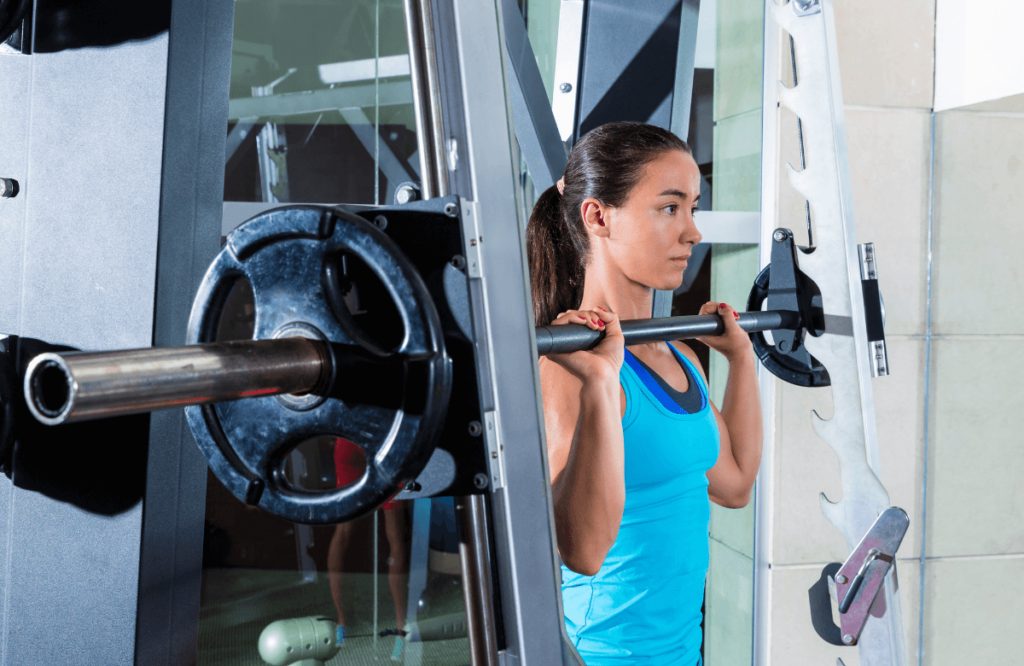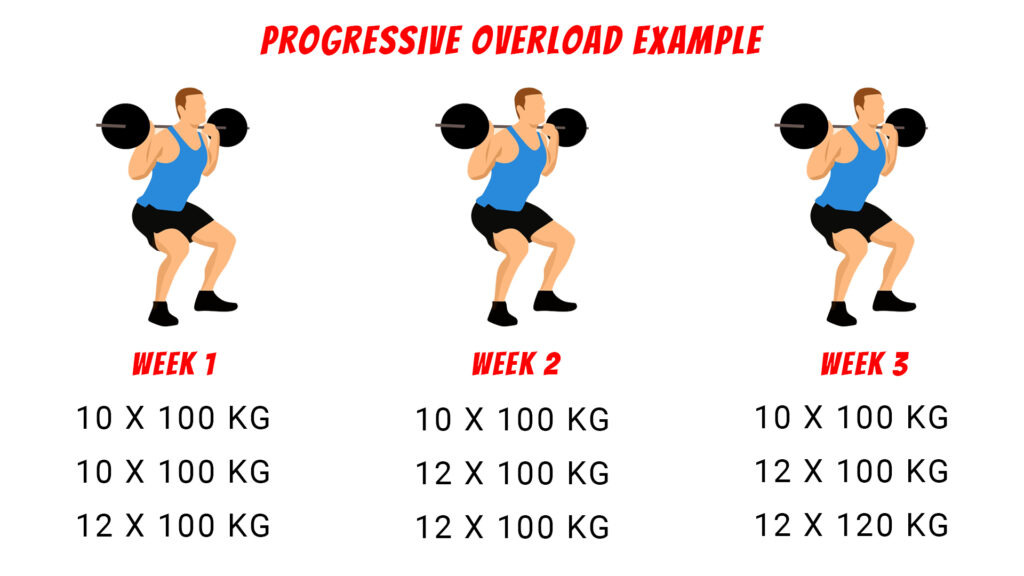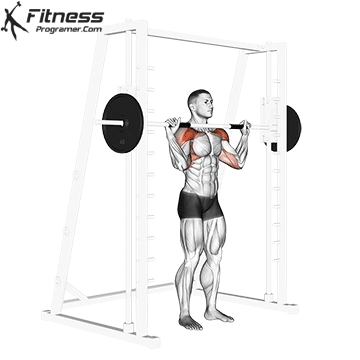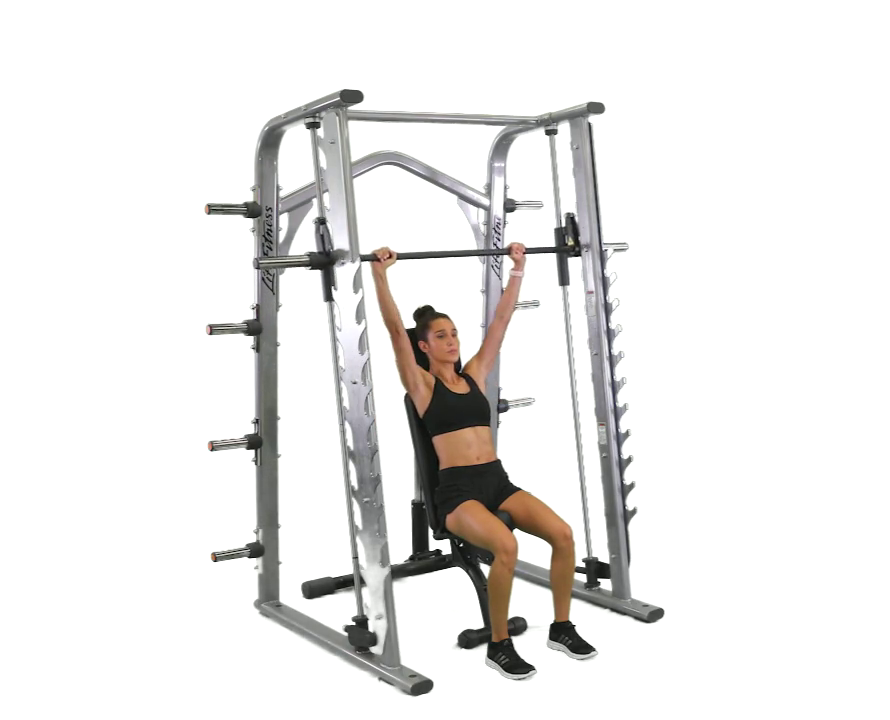The shoulder press, a fundamental exercise for building upper-body strength and muscle mass, targets the deltoid muscles, triceps, and various stabilizing muscles of the shoulder girdle. While traditional shoulder presses using free weights like dumbbells and barbells are highly effective, the Smith machine shoulder press offers a safe and controlled alternative, making it accessible to individuals of all fitness levels. In this comprehensive guide, we’ll walk you through the proper technique, benefits, variations, and common mistakes of the Smith machine shoulder press to help you maximize your results and minimize the risk of injury. Let’s know how to master this exercise to get strong and defined shoulders.
Understanding the Smith Machine Shoulder Press
The Smith machine is a piece of weightlifting equipment consisting of a barbell fixed within steel rails or tracks. Unlike traditional free weights, the Smith machine’s barbell moves along a vertical plane, allowing for guided, linear movement patterns. The Smith machine shoulder press involves pressing the barbell overhead while seated or standing, primarily targeting the deltoid muscles of the shoulders.

Benefits of the Smith Machine Shoulder Press
Safety
The guided movement of the Smith machine reduces the risk of injury by providing stability and support throughout the exercise. This is particularly beneficial for beginners or individuals recovering from shoulder injuries. Most importantly, whether seated or standing, this compound movement can be an outstanding addition in your shoulder workout routine as it is one of the most amazing deltoid exercises.
Controlled Range of Motion
The fixed path of the Smith machine ensures a consistent range of motion, allowing you to focus on proper form and technique without the need for stabilization.
Muscle Isolation
Even though it is considered a compound movement, the Smith machine shoulder press targets the deltoid muscles of the shoulders while minimizing involvement of other muscle groups, allowing for more targeted muscle activation and development.
Progressive Overload
The Smith machine allows for easy adjustment of weight increments, making it suitable for progressive overload training and strength progression over time.

Versatility
The Smith machine shoulder press can be performed in various positions, including seated, standing, or with different grip widths, allowing for versatility in training and targeting different areas of the shoulders.
Also Read: Cable Lateral Raise: How to, Tips, Benefits & Variations!
How to Perform the Smith Machine Shoulder Press with Perfect Form!
Setup
Begin by adjusting the height of the Smith machine barbell to shoulder level. Position yourself underneath the barbell with your feet shoulder-width apart and your knees slightly bent. Grip the barbell with an overhand grip, slightly wider than shoulder-width apart.
Positioning
Engage your core and maintain a neutral spine throughout the movement. Your head, shoulders, and hips should be in proper alignment. Keep your elbows slightly in front of the barbell and your wrists stacked directly below your elbows.
Execution
Press the barbell overhead by extending your arms fully, driving the barbell upwards in a controlled manner. Keep your shoulders down and back, avoiding shrugging or rounding of the shoulders. Pause briefly at the top of the movement, then lower the barbell back down to shoulder level with control.

Breathing
Inhale as you lower the barbell towards your shoulders, and exhale as you press the barbell overhead. Focus on maintaining a steady and controlled breathing pattern throughout the movement.
Range of Motion
Lower the barbell until your elbows are at approximately 90 degrees, allowing for a full range of motion while maintaining tension in the deltoid muscles. Avoid locking out your elbows at the top of the movement so that you can prevent any type of strain on the joints.
Repetition
Complete the desired number of repetitions with proper form and technique. Aim for 8-12 repetitions per set, adjusting the weight as needed to challenge your muscles while maintaining good form.
Cooldown
Once you’ve completed your sets, carefully rack the barbell back into the Smith machine and take a moment to stretch your shoulders and upper body to promote recovery and flexibility.
Incorporating the Smith Machine Shoulder Press into Your Routine
The Smith machine shoulder press can be incorporated into your upper-body training routine to build strength, muscle mass, and shoulder stability. Aim to include the shoulder press as part of a comprehensive workout program that targets all major muscle groups of the upper body, including the chest, back, shoulders, and arms. For beginners, including shoulder exercises with chest and triceps is the best while for advanced level, one should make a separate day to train the shoulders for maximise the muscle and strength gain while optimizing recovery.
As a beginner, perform the Smith machine shoulder press 2-3 times per week, with 3-4 sets of 8-12 repetitions per session. Start with a light weight to warm up the muscles and gradually increase the weight as you become more comfortable with the movement. For intermediate athletes, 1-2 times per week is more than enough to train the shoulders.
In addition to the Smith machine shoulder press, include a variety of other shoulder exercises such as lateral raises, front raises, and rear deltoid flies to target different areas of the shoulders and ensure balanced muscle development.
Common Mistakes to Avoid
Arching the Back
Avoid leaning back excessively or arching your lower back during the shoulder press. Maintain a neutral spine to prevent strain on the lower back and maintain proper alignment.
Shrugging the Shoulders
Keep your shoulders down and back throughout the exercise, avoiding shrugging or hunching the shoulders towards the ears. This helps engage the deltoid muscles and prevents tension in the neck and upper traps.
Locking Out the Elbows
Avoid locking out your elbows at the top of the movement, as this can strain the elbow joints and reduce muscle tension in the shoulders. Keep a slight bend in the elbows to maintain tension in the muscles throughout the exercise.
Using Excessive Momentum
Focus on controlled, deliberate movements rather than using momentum to lift the weight. Avoid swinging or jerking the barbell, as this can compromise form and increase the risk of injury.
Overarching the Neck
Keep your neck in a neutral position and avoid jutting your chin forward or tilting your head back excessively. Maintain a relaxed and aligned neck position throughout the exercise to prevent strain on the cervical spine.
Variations of the Smith Machine Shoulder Press
Seated Smith Machine Shoulder Press
Perform the shoulder press while seated on a bench with back support. This variation helps isolate the shoulder muscles even more and minimizes involvement of the lower body.

Single-Arm Smith Machine Shoulder Press
Perform the shoulder press with one arm at a time to address muscle imbalances and increase stability and coordination. This variation allows for unilateral training and focuses on isolating each shoulder independently.
Behind-the-Neck Smith Machine Shoulder Press
Lower the barbell behind your neck instead of in front of your head, targeting different areas of the shoulders and upper back. Use caution with this variation and ensure proper shoulder mobility to avoid strain or injury.
Conclusion
The Smith machine shoulder press is a versatile and effective exercise for building upper-body strength, muscle mass, and shoulder stability. By mastering proper technique, avoiding common mistakes, and incorporating variations into your routine, you can maximize the benefits of this exercise and achieve your fitness goals safely and effectively. Whether you’re a beginner or an experienced lifter, the Smith machine shoulder press offers a valuable addition to your workout arsenal for sculpting strong, defined shoulders and improving overall upper-body strength. Hopefully, you found this article helpful enough. If you really did then let us know your unfiltered thoughts in the comment section without any hesitation. Thanks for visiting and appreciating our work.
